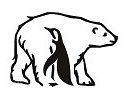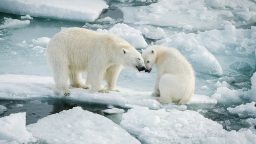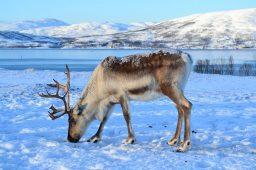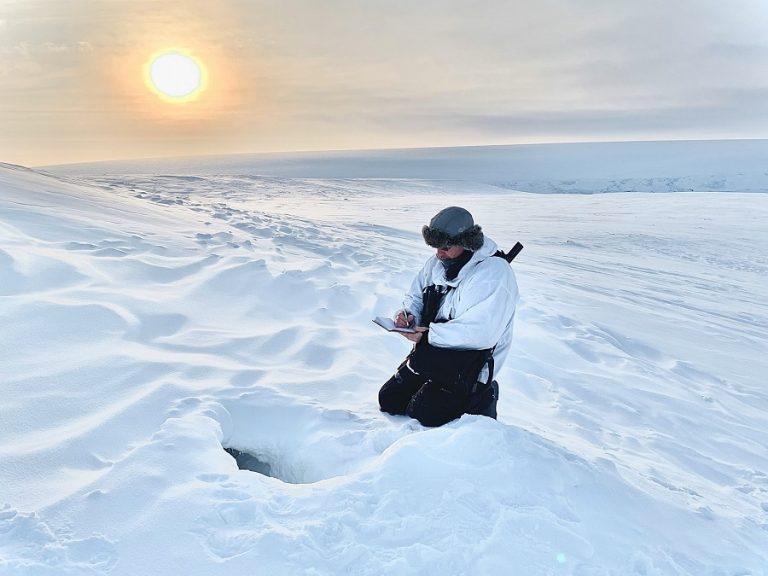
An employee of the Russian Arctic National Park at the polar bear’s den. Photo: A. Ermolin
Modernity and traditional knowledge
When humans interact with wild animals, it is necessary to use at the modern level the so-called “traditional knowledge”, which has been developed over many centuries by the foundations of local nature management. In terms of wildlife, this is especially noticeable in domestic reindeer husbandry, when mining companies are forced to operate in pasture areas.
But traditions, practical skills and ways of long-term co-existence with the harsh northern nature of the indigenous peoples living here are no less important so that modern people can resist and not irrevocably destroy this fragile “universe”, simply trying to bring their own “urban” idea of its structure.
It would seem that new methods of scientific knowledge make it possible to do without using the “everyday” experience of the northern peoples. Satellite technologies, unmanned aerial vehicles, chemical laboratories – can’t they replace the old-timers’ empirical knowledge, which has been passed down from mouth to mouth for many generations, often without written documentation? Turns out, no, they can’t.
For example, the Chukchi have as many as ten gradations of polar bears by age and gender, and another twelve by type of behavior. Traditional knowledge reflects the physiological state of the bear, and allows you to adjust human behavior at the moment of meeting the animal. This is very important, because such a detailed division contributes to the correct interpretation of the intentions of the beast towards man.
The aspect of choosing clothes for being among polar bears is interesting. Yes, clothes should be warm and provide the opportunity to stay for a long time in conditions of low air temperature and possible strong winds with a blizzard. But the choice of its color is also very important! What color should I wear if the goal is to study polar bears? And what should an employee accompanying a group of tourists wear?
Some tips in this regard can be obtained from the experience of the inhabitants of Chukotka. We are used to dressing either in colors that match the surroundings, or in something bright to be seen from afar. The scientist will try to wear a white camouflage suit so as not to stand out against the background of ice and snow. This, of course, will not prevent the spread of human odors, but it will still allow you to remain invisible longer.
But how does the polar bear react to this? After all, if tourists are also invisible, won’t this lead to the fact that the polar bear will not detect them in advance? Probably, we should dress everyone in red! We already know that polar bears have good eyesight, they are quite capable of distinguishing the basic range of colors.
This is where traditional knowledge comes to the rescue: if clothes are red, it can be associated with blood by a predator, especially if a person in such clothes is lying down or crouching low, it means he is injured. It is necessary, therefore, to avoid such clothes. The red or orange color causes increased curiosity about the object on the part of the polar bear. But the white color, on the contrary, is calm and even indifferent.
Well, dark tones are the reason for the cautious attitude of the beast towards man. Knowing such things, it is already possible to more meaningfully choose polar clothing for a particular category of people. Sometimes there are “hits” – for example, in the Russian Arctic National Park, unaware of the experience of the northern peoples in dealing with polar bears, they chose a dark color of clothing for employees on the third attempt.
Precautions when encountering polar bears
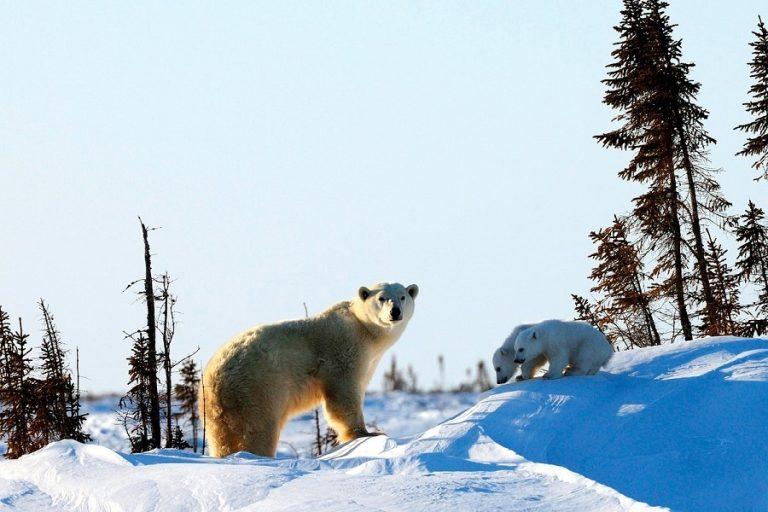
A bear with cubs. Photo: Thomas Sbampato / globallookpress.com
It is not uncommon for people in the Arctic to encounter these animals. These encounters are potentially dangerous, but not every polar bear immediately pounces on a person seen from afar. Nevertheless, it is useful to be able to know the behavior of predators. Of course, either a specialist or a person who has lived among polar bears for a long time and has experience can assess the degree of threat of a particular bear.
The Chukchi have accumulated such experience over about a couple of millennia of their life together with polar bears, so it is necessary to know it. This experience tells us, without any scientific articles, that whole groups of bears can gather near a food source (a beached whale or dead walruses in a rookery). Such aggregations have been repeatedly described in the scientific literature and are an important feature of the life of polar bears today.
Polar bears “prefer individual space.” Moreover, it is about 15-20 meters, as traditional knowledge tells us. And since it was formed during the direct contact of the Chukchi with animals in a variety of situations, it seems more reliable to believe it than the recommendations contained in some instructions that you should shoot at the beast from 30 meters away.
Scaring away a polar bear with an outstretched stick (formerly a spear) is a traditional Chukchi technique. Experience says that when an animal approaches, you cannot run away or scream. You need to stand still. Well, and lift up what is in your hands. If there is nothing, raise your hands up. Why do you have to behave this way? The answer is quite simple: “When bears meet, a dominance check occurs. Bears always bluff and attack.”
So a person’s demonstration of himself in the form of a taller and larger object can prevent an attack and stop a polar bear, which sees that there is clearly a “dominant” creature in front of him. This technique was actively used by the staff of the Wrangel Island Nature Reserve, who spent a lot of time with the locals and knew their techniques. The “big cudgel” method is perfectly applicable in experienced hands.
Taboo when hunting bears
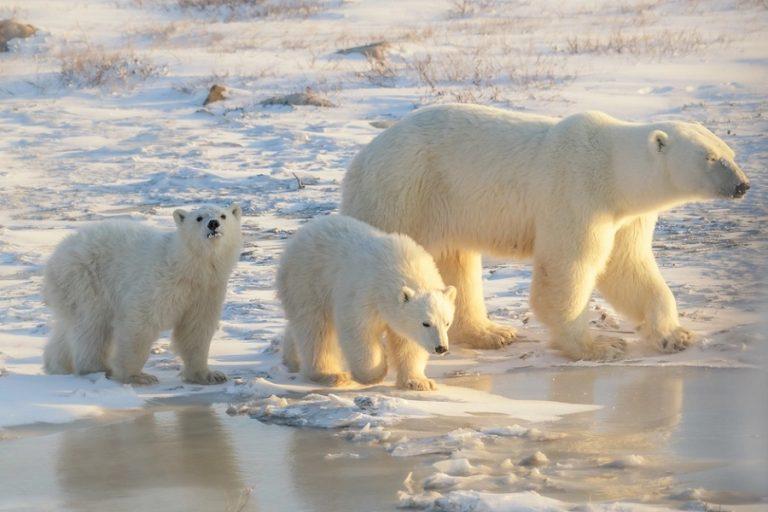
The bear family.
Despite the fact that polar bears were hunted and a source of food for the Chukchi, there were several restrictions on this process.
These are the “seven strict taboos” (from Vladilen Kavra’s book “The Genus of the polar bear, 2016):
⦁ You can not get bears with cubs. To break up a family by killing one bear.
⦁ You can not get bears in dens. Like humans, the den is the home of polar bears.
⦁ One family clan cannot capture more than one polar bear for two or three years.
⦁ It is forbidden to get animals for families with infants or young children.
⦁ Bears with human behavior (yawning, covering their muzzle with their paw, playing, etc.) should not be hunted.
⦁ Bears should not be hunted during the summer. Other food is enough. The pile on the hide was fading at that time and was very rare.
⦁ There were restrictions on the extraction of families with a bear family. For example, there was a strict order of bear prey in the entire family clan.
The indigenous people considered the polar bears’ den to be their home. The extraction of bears in dens was strictly prohibited! Hunters were always informed about the location of dens, they avoided these places. There were exceptions: it was allowed to get a bear in the summer in case of a relative’s illness.
The spirit of a slain bear (or a deceased relative) lived in nature for up to 2-3 years, being the guardian spirit of the family. This time was considered the waiting period for the transmigration of the guardian spirit to a person or animal, so it was forbidden to kill a bear. The soul of the bear had a kinship connection with some kind of family:
It was forbidden to get animals for families with young children. The soul of young children is very vulnerable. In a dream, a child could be very scared when he saw the spirit of a dead bear and leave the body, or vice versa, the spirit of a dead bear could call and take (kidnap) the child’s soul. During this period, mothers did not cut their hair and always let it down before going to bed. It was believed that at the moment of danger, the hair entangled and held the child’s soul.
And until the “civilized white man” came to the Arctic, there was no need to worry about the fate of the bears, the northern peoples lived with them in a relatively harmonious state. But, alas, as soon as the skins of polar bears hit the markets of Europe and America, the unrestrained fishing of this species began. The pursuit of money quickly led to the fact that traditional knowledge was forgotten or perceived as “remnants of the past.”
Polar bears were shot everywhere and always without counting, ancestral dens were ruthlessly dug up, cubs were taken away, and bears were killed on the spot. Even many indigenous people, having forgotten the commandments of their ancestors about the extraction of only one animal, took part in this process. What all this led to is well known: by 1956, there were so few polar bears in the Soviet Arctic that an absolute ban on their fishing had to be imposed.
Ivan Mizin
